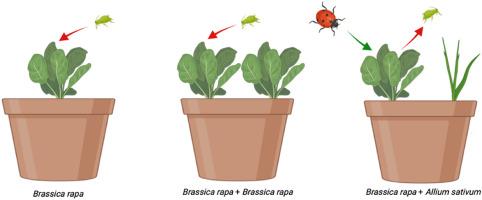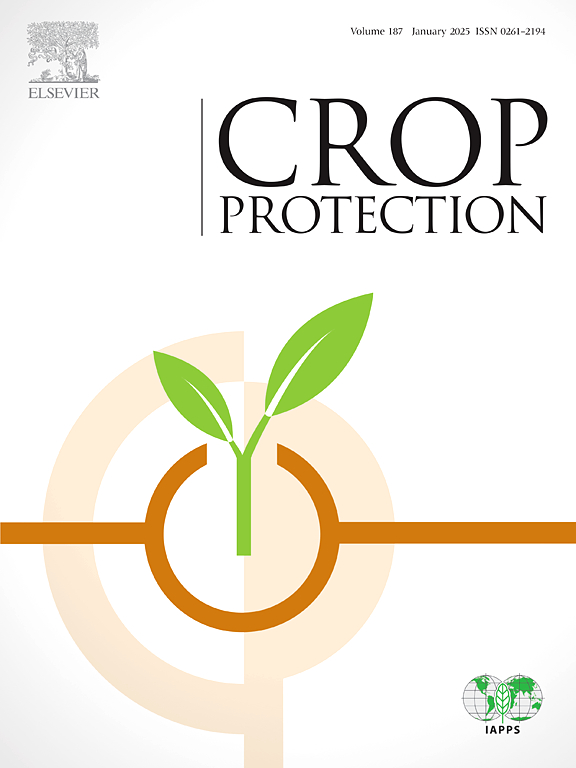将大蒜作为抑制柿蝇蛆侵袭甘蓝型油菜的伴生植物
IF 2.5
2区 农林科学
Q1 AGRONOMY
引用次数: 0
摘要
伴生种植是将不同植物物种种植在一起的做法,是一种可持续的害虫管理策略。然而,大蒜作为芸苔属植物的伴生植物在抑制蚜虫,特别是抑制蚜蝇(Myzus persicae (Sulzer))(半翅目:蚜科)方面的具体作用还不十分清楚。本研究调查了大蒜(Allium sativum L.,Asparagales: Amaryllidaceae)与芸苔属植物 Brassica rapa L.(Brassicales: Brassicaceae)搭配种植以减少柿蚜虫害的潜力,并探讨了其对生物控制剂 Harmonia axyridis Pallas(鞘翅目:蚜科)的影响。我们假设,与单一栽培芸苔属植物相比,A. sativum 和 B. rapa 的组合将协同减少蚜虫的侵扰。为了验证这一假设,我们在三种条件下评估了 M. persicae 在芸苔属植物上的表现:单一芸苔属植物 (B)、两种芸苔属植物 (BB) 和一种芸苔属植物与大蒜 (BG) 的组合。对蚜虫的存活率、繁殖力、发育时间和种群数量增加等参数进行了测量。此外,Y-olfactometer 生物测定评估了 M. persicae 和 H. axyridis 的行为反应。结果表明,与 B 和 BB 相比,BG 组合能显著降低蚜虫的存活率、繁殖率和种群增长,同时延缓发育时间。M.persicae更喜欢B和BB植物的挥发物,而H. axyridis则更喜欢BG的挥发物,这表明大蒜具有增强生物控制剂招募的潜力。这项研究强调了大蒜作为一种伴生植物的潜力,它可以改善芸苔属作物对M. persicae的保护,并提高生物防治剂的效果。本文章由计算机程序翻译,如有差异,请以英文原文为准。

Garlic as a companion plant for suppressing Myzus persicae infestation in Brassica rapa
Companion planting, the practice of growing different plant species together, can be a sustainable pest management strategy. However, the specific role of garlic as a companion plant for Brassica in aphid suppression, particularly against Myzus persicae (Sulzer) (Hemiptera: Aphididae), is not well understood. This study investigated the potential of planting garlic (Allium sativum L., Asparagales: Amaryllidaceae) with Brassica rapa L. (Brassicales: Brassicaceae) to reduce M. persicae infestations and explores its impact on the biocontrol agent Harmonia axyridis Pallas (Coleoptera: Coccinellidae). We hypothesized that the combination of A. sativum and B. rapa would synergistically reduce aphid infestations compared to Brassica monocultures. To test this, M. persicae performance was evaluated on Brassica plants under three conditions: a single Brassica plant (B), two Brassica plants (BB), and a Brassica plant with garlic (BG). Parameters such as aphid survival, fecundity, developmental time, and population increase were measured. Additionally, Y-olfactometer bioassays assessed the behavioral responses of M. persicae and H. axyridis. The results showed that the BG combination significantly reduced aphid survival, fecundity, and population growth while delaying developmental time compared to B and BB. M. persicae preferred volatiles from B and BB plants, while H. axyridis was more attracted to BG volatiles, indicating garlic's potential to enhance biocontrol agent recruitment. This study highlights the potential of garlic as a companion plant to improve Brassica crop protection against M. persicae and enhance the effectiveness of biocontrol agents.
求助全文
通过发布文献求助,成功后即可免费获取论文全文。
去求助
来源期刊

Crop Protection
农林科学-农艺学
CiteScore
6.10
自引率
3.60%
发文量
200
审稿时长
29 days
期刊介绍:
The Editors of Crop Protection especially welcome papers describing an interdisciplinary approach showing how different control strategies can be integrated into practical pest management programs, covering high and low input agricultural systems worldwide. Crop Protection particularly emphasizes the practical aspects of control in the field and for protected crops, and includes work which may lead in the near future to more effective control. The journal does not duplicate the many existing excellent biological science journals, which deal mainly with the more fundamental aspects of plant pathology, applied zoology and weed science. Crop Protection covers all practical aspects of pest, disease and weed control, including the following topics:
-Abiotic damage-
Agronomic control methods-
Assessment of pest and disease damage-
Molecular methods for the detection and assessment of pests and diseases-
Biological control-
Biorational pesticides-
Control of animal pests of world crops-
Control of diseases of crop plants caused by microorganisms-
Control of weeds and integrated management-
Economic considerations-
Effects of plant growth regulators-
Environmental benefits of reduced pesticide use-
Environmental effects of pesticides-
Epidemiology of pests and diseases in relation to control-
GM Crops, and genetic engineering applications-
Importance and control of postharvest crop losses-
Integrated control-
Interrelationships and compatibility among different control strategies-
Invasive species as they relate to implications for crop protection-
Pesticide application methods-
Pest management-
Phytobiomes for pest and disease control-
Resistance management-
Sampling and monitoring schemes for diseases, nematodes, pests and weeds.
 求助内容:
求助内容: 应助结果提醒方式:
应助结果提醒方式:


